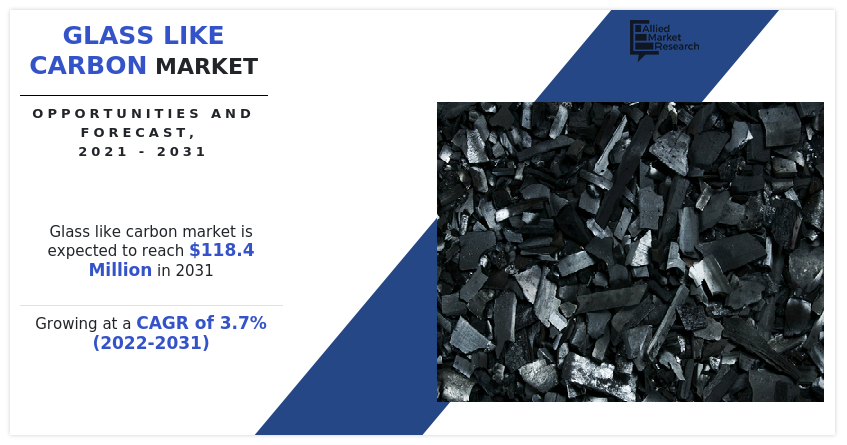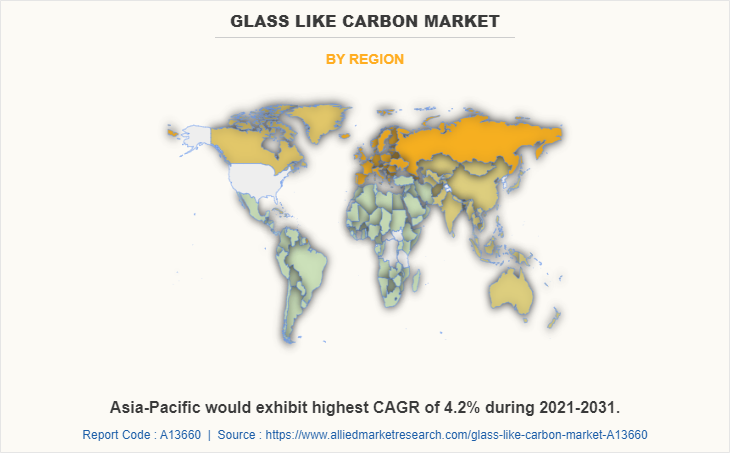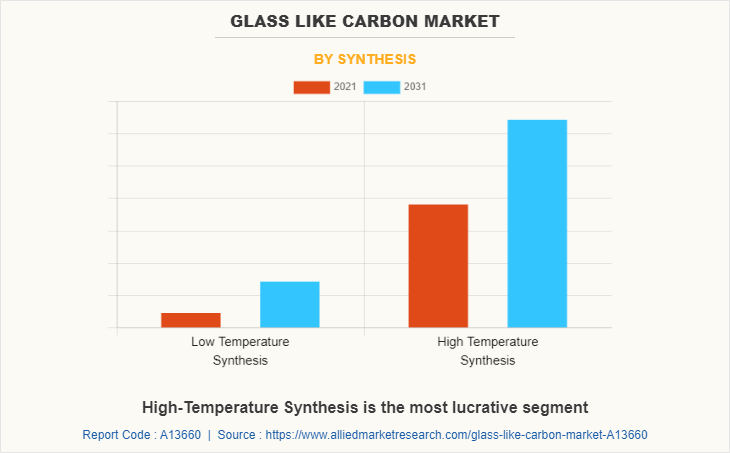Glass Like Carbon Market Research, 2031
The global glass like carbon market was valued at $82.3 million in 2021, and is projected to reach $118.4 million by 2031, growing at a CAGR of 3.7% from 2022 to 2031.
Glass-like Carbon is a brittle form of carbon with exceptional properties which has paved new application areas for the carbon element. The material is very stable at high temperatures and continuous high-level heating or cooling does not cause any prominent effects on the material. These properties have made Glass-like Carbon desirable for applications where performance development has greater importance than cost.

The increase in demand for consumer electronics has surged the popularity of electrochemical coating applications where glass-like carbon is widely used as electrodes. For instance, according to a report published by National Investment Promotion and Facilitation Agency, India’s export of electronic devices is set to increase from $10 billion in 2021 to $120 billion by 2026. This is projected to enhance the demand for glass-like carbon in the growing electronics sector; thus fuelling the market growth. Furthermore, the rise in disposable income, rapid growth in population, and increase in urbanization has created a massive demand for regular and advanced electronic devices such as washing machines, smartphones, televisions, computers, and others where glass-like carbon-based semiconductors is widely used in integrated circuits. For instance, according to data published by International Data Corporation (IDC), the worldwide shipments for smart home devices have reached 801.5 million units in 2020 which is a 4.5% increase over 2019. This is projected to propel the growth of the glass-like carbon market during the forecast period.
However, the production of glass-like carbon requires highly sophisticated equipment. Also, the isolated chambers used during heat treatment are much costlier. This restrains the manufacturers with low investment potential to enter into the glass-like carbon production; thus, hampering the growth of the glass-like carbon market.
On the contrary, the emergence of compressed form of glassy carbon opens possibilities for aerospace applications where low weight and high strength materials are required. Furthermore, glassy carbon is ultra-strong, lightweight, elastic and electrically conductive that makes it best suited for use in integrated circuits, sensors, semiconductors, and other electronic devices of aircrafts. This factor is predicted to create remunerative opportunities for the expansion of the glass-like carbon market in the future.
The The glass like carbon market is segmented into synthesis, application and region. On the basis of synthesis, the market is bifurcated into low temperature synthesis and high temperature synthesis. Depending on application, it is fragmented into electrode material, surgical implants, semiconductors and electronics, temperature management, and others. Region-wise, the market is studied across North America, Europe, Asia-Pacific, and LAMEA.
The major companies profiled in this report include ALS Co., Ltd, Bioanalytical Systems, Inc, Final, Advanced Materials, Merck KGaA, Metrohm AG, PalmSens BV, Redoxme AB, Structure Probe, Inc., Tokai Carbon, and XRD Graphite Manufacturing Co., Ltd.

The Asia-Pacific glass-like carbon market size is projected to grow at the highest CAGR of 4.2% during the forecast period and accounted for 20.53% of glass-like carbon market share in 2021. This is attributed to the proliferating demand for glass-like carbon from various end-use sectors such as consumer electronics, aerospace, and others which in turn have led the glass-like carbon manufacturers to increase their production capacities. Furthermore, China's electronic sector which has forced the glass-like carbons manufacturers to produce more efficient glassy carbons used in used manufacturing diodes, integrated circuits, sensors, and others. Furthermore, countries such as Japan and Taiwan have a large electronics industry base and consumer electronics appliances industry which in turn has enhanced the performance of glass-like carbon market in the Asia-Pacific region.

In 2021, the high temperature synthesis segment was the largest revenue generator, and is anticipated to grow at a CAGR of 3.8 during the forecast period. This is attributed to the fact that high temperature synthesis offers several advantages to the physical behavior of glassy carbon such as higher elastic modulus, greater polarity and wettability, better resistance to oxidation, and lower permeability to gases. Furthermore, the glassy carbon produced from high temperature synthesis has fewer impurities and is more electrically conductive as compared to glassy carbon produced from low temperature synthesis. These factors have made manufacturers become more linear towards adopting high temperature synthesis.
By Application
Surgical implants is projected as the fastest growing segment
By application, the electrode material segment dominated the global market in 2021, and is anticipated to grow at a CAGR of 3.9% during forecast period. This is attributed to the fact that Rapid technological advancements coupled with rise in R&D activities has surged the development of fuel cell, batteries, and other materials where glassy carbon-based electrodes are widely used for electrochemical applications. For instance, according to a report published by National Institution for Transforming India (NITI) Aayog, India’s expected demand for advance batteries till 2030 is about 1100 GWh across different use cases. These factors are augmenting the growth of the electrode material segment in the global glass-like carbon market.
IMPACT OF COVID-19 ON THE GLOBAL GLASS-LIKE CARBON MARKET
- The novel coronavirus is an incomparable global pandemic that has spread to over 180 countries and caused huge losses of lives and the economy around the globe.
- The glass-like carbon market has been negatively impacted due to the wake of COVID-19 pandemic owing to its dependence on electronics, automotive, aerospace, and other sectors. According to an article published by The Economic Times, the exports of electronic devices such as computers, smartphones, and others have dipped due to supply chain issues.
- Also, several electronics companies have either shutdown or shrank their operations due to the risk of infections among the workforce where glass-like carbon is used as semiconductors. This has temporarily hampered the demand for glass-like carbon market amid the COVID-19 period.
- In addition, the falling income of customers has led to contraction in demand for glass-like carbon based brake pad systems among the automotive sectors. For instance, according to a report published by Auto News, the sales of passenger cars saw a 30% decline in March 2020 as compared to March 2019, owing to lockdowns and shutdowns of auto plants.
- In addition, the travel restrictions imposed by the governments of various countries have led the aerospace & aviation sectors to witness temporary downfall.
- In addition, the travel restrictions imposed by the governments of various countries have led the aerospace & aviation sectors to witness temporary downfall.
- However, the rising sale of smartphones, laptops, tablets, and other consumer electronic devices have reported a rise in sales during the first quarter of 2021. This is anticipated to enhance the performance of glass-like carbon market for consumer electronics segments post COVID-19 scenario.
Key Benefits For Stakeholders
- This report provides a quantitative analysis of the market segments, current trends, estimations, and dynamics of the glass-like carbon market analysis from 2021 to 2031 to identify the prevailing glass-like carbon market opportunities.
- Market research is offered along with information related to key drivers, restraints, and opportunities.
- Porter's five forces analysis highlights the potency of buyers and suppliers to enable stakeholders to make profit-oriented business decisions and strengthen their supplier-buyer network.
- An in-depth analysis of the glass-like carbon market segmentation assists to determine the prevailing market opportunities.
- Major countries in each region are mapped according to their revenue contribution to the global market.
- Market player positioning facilitates benchmarking and provides a clear understanding of the present position of the market players.
- The report includes the analysis of the regional as well as global glass-like carbon market trends, key players, market segments, application areas, and market growth strategies.
Glass Like Carbon Market Report Highlights
| Aspects | Details |
| By Synthesis |
|
| By Application |
|
| By Region |
|
| Key Market Players | Redoxme AB, Structure Probe, Inc, PalmSens BV, Merck KGaA, Final Advanced Materials, Metrohm AG, Tokai Carbon, Bioanalytical Systems, Inc., XRD Graphite Manufacturing Co., Ltd, ALS Co., Ltd |
| | Others |
Analyst Review
According to CXOs of leading companies, the global glass-like carbon market is expected to exhibit high growth potential during the forecast period. The drastic growth in adoption rate of smart phones, tablets, and introduction of highly advanced consumer electronic devices have surged the growth of the glass-like carbon market. In addition, the increase in trend for fuel cells and advanced battery systems where glass-like carbon-based electrode plays a significant role in electrochemical applications is expected to positively impact the growth of this market.
According to some CXOs, due to the considerable growth in the automotive industry, there is an increase in the demand for glassy-carbon based efficient brake pad systems, and this is expected to open new growth opportunities for the market. Emergence of modern aircraft with advanced avionics where glassy like carbon is used for manufacturing sensors, semiconductors, and other electronic components are projected to widen the growth trajectory of this market. As there is a rise in the adoption rate of consumer electronics devices, the assessment period from 2021 to 2031 is anticipated to be a transformational phase for the growth of this market.
The emergence of the compressed form of glassy carbon opens possibilities for aerospace applications where light-weight and high-strength materials are required.
The electrode material segment dominated the global market in 2021 and is anticipated to grow at a CAGR of 3.9% during the forecast period.
Europe accounted for the largest revenue share in the global glass like carbon market, growing at a CAGR of 4.0% during the forecast period.
The global glass-like carbon market is projected to reach $118.4 million by 2031, growing at a CAGR of 3.7% from 2022 to 2031.
The major companies profiled in this report include ALS Co., Ltd, Bioanalytical Systems, Inc, Final, Advanced Materials, Merck KGaA, Metrohm AG, PalmSens BV, Redoxme AB, Structure Probe, Inc., Tokai Carbon, and XRD Graphite Manufacturing Co., Ltd.
Loading Table Of Content...



